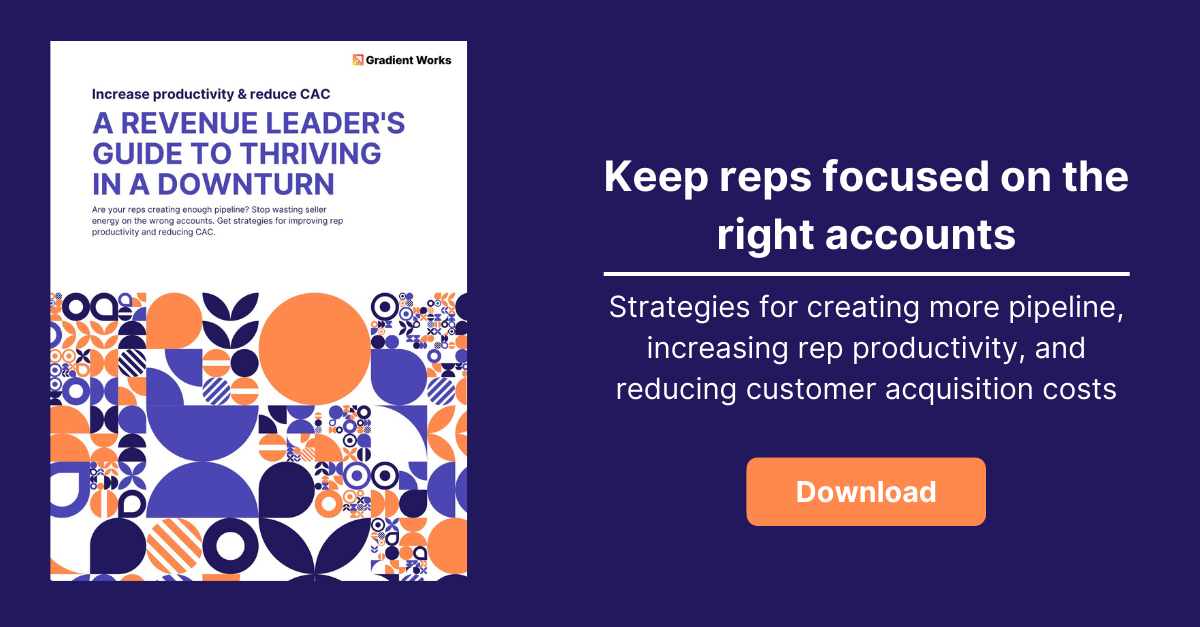A recurring theme this year is sales productivity. How can we get the most from our sales reps?
You may have a smaller team than last year. You may not be able to hire new folks. You may be worried about losing your top performers. You probably still have a big attainment goal, and you’re somehow supposed to hit it with a smaller team.
All this means you need to be sure every single sales rep is as productive and efficient as possible. Because seller time is money. Don’t waste it on accounts they can’t work and activities that don’t contribute to pipeline.
As you may have heard us say, your quota capacity is more precious than it's ever been. You can’t waste it on spray and pray outreach. Instead, you need to be sure that sales reps are focused on the highest value sales activities with highest potential accounts at all times. So, what can you do to increase sales productivity?
1. Change up how you allocate accounts
In the fat years of our recent past, it may not have mattered too much which accounts your sellers focused on. Maybe you had plenty of inbound leads to feed reps, or large enough territories that even untargeted outreach found plenty of opportunities.
But those days are gone, and you likely need to find a better account allocation plan for reps. The territories you used last year probably won't work this year.
You now need to think more about hitting quota in the most sustainable way, so you're not burning out your accounts. How are you covering your TAM holistically? You need something more maintainable, more consistent, and more predictable than in years past.
You should consider a territory or account allocation model more responsive to the particular challenges sales teams are facing now. Something like dynamic books, which ensure reps are focused on the best possible accounts at any time. Instead of assigning each rep a territory at the beginning of the year, a dynamic books approach rotates the highest potential accounts at any given time to reps with availability to work them.
That means reps are always engaging the highest potential accounts at all times, and they're not wasting time on accounts that aren't ready to buy or aren't a good fit right now. It also keeps your pool of addressable accounts from getting overworked.
(Curious about dynamic books? We'd be happy to talk more.)
Regardless of how you do it, be sure reps are ruthlessly focused on accounts that are ready to buy, that are a good fit for your ICP and product, or that look similar to accounts that have converted in the past.
2. Incentivize the rep behaviors you want to see
You can tell sellers what to do, or you can create processes that motivate them to do those things.
First, what behaviors do you want to encourage? Does picking up the phone work better with your market? Do you get higher reply rates on email cadences of a certain length? Are there product features reps should always include in a pitch? Are there segments of your market they should be working more? Figure out what your highest-value sales activities are, and then provide some kind of incentive to reps who do those things.
For example, let's say you want reps to find more self-sourced opportunities. But most Account Executives haven't had to spend much time prospecting the past few years (not to mention most of them probably don't really want to). So how can you convince them to do more outbounding? You could say, for example, that if an AE self-sources 10 opps every month, they get distributed more high-intent inbound leads. (This is hard to do with static territories, but easy to do with dynamic books, by the way.)
Incentives don't need to be directly monetary, though of course spiffs have their place and may work for your team. Think about what other options you have available to you and get creative.
But whatever you do, don't screw with rep compensation, especially now. Because you need to retain your best-performing reps, and they may be thinking about leaving...
3. Do more to increase rep satisfaction
As teams cut headcount, reps are being asked to do more. Specialists are being replaced with utility players, who need to do everything from outbound prospecting to qualification to demos to closing.
So it's probably no coincidence that Gartner reports that 89% of sellers feel burnt out and 54% are actively looking for a new opportunity.
Two of the main contributors to "seller drag" (again, per Gartner) are vague, unactionable manager feedback and the burden of admin tasks that don't contribute to pipeline. I'd also suggest that perceptions of unfairness and imbalance are contributing to that drag.
What can you do to better support your reps?
We'll address vague manager feedback in the next section on analytics. The burden of administrative tasks can be relieved by removing some of those tasks from sellers' hands. What you can automate? What you can eliminate? You may not know the true impact of manual tasks on your reps' time, so now would be a good time to check in with them, and better understand how they spend their time. If a rep is spending an hour a day prospecting, is there a way you can help them focus in on the right accounts or get updated contact info more quickly? Figure out what tasks are costing them the most time, and tackle each one.
Perceptions of unfairness and imbalance are a little trickier. Depending on what your team has been through the past few months, sellers may be on edge - worried their jobs may be cut, their workload may increase, and most importantly, their compensation will change. They may be dealing with new processes or messaging. How can you reassure and empower your reps to work through these changes?
4. Get better with analytics
You may think your sales managers are data-driven. You probably have tons of dashboards and reports to track pipeline. You definitely know what "good" performance looks like, and have benchmarks for different stages in your pipeline. But no matter how smart your sales metrics were before, there's never been a better time to fix and focus your reporting. A lot has changed.
Figure out where to spend your (and your sales managers') limited time. Stop wasting time and effort on big bulky dashboards, and focus in on a few key metrics that tell you exactly how deals are moving through your pipeline now. Make sure they're actionable metrics that help you pinpoint issues before they become show up in your attainment numbers, or help you identify quick areas for improvement.
This pertains to individual rep coaching in particular. We all know that sales coaching can be hit or miss, so spend some time making sure you have both the tools and the data to help managers customize coaching for each rep. Instead of a blanket application of best practices, the right metrics allow you to customize feedback on a rep-by-rep basis. This will have outsized returns in improvements in individual rep performance and satisfaction. (Note that this may require some additional training for sales managers to become more effective coaches. Sales coaching coaching, if you will.)
4.5. Don't do more with less. Do less better.
To improve sales productivity is not blindly have reps do more activities. More calls and more emails aren't going to magically create more pipeline. Instead, have reps focus on fewer, higher potential accounts, with the most efficient outreach. How do you decide what a full-cycle rep can actually do? How much can they handle? At what point are there diminishing returns?
Again, this is all about ruthless focus and execution. Figure out what's most important to pipeline creation and closing business, and do those well. Do less, but do it better.






.png)